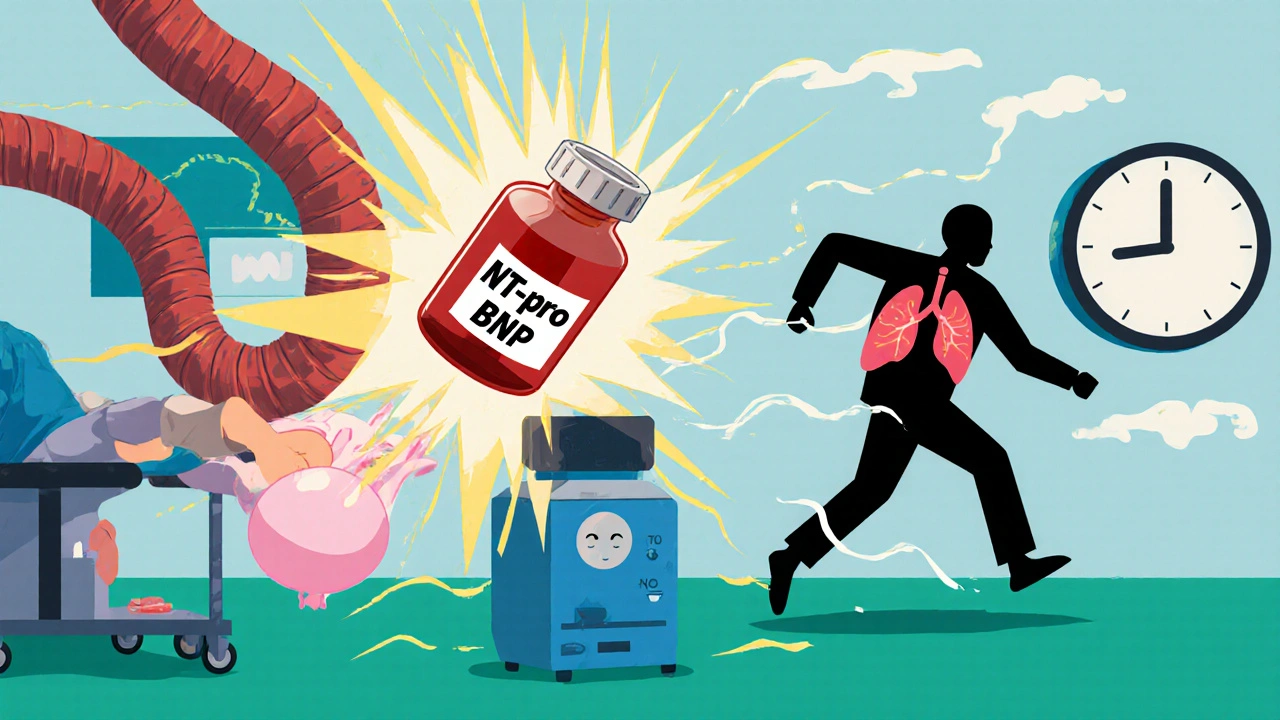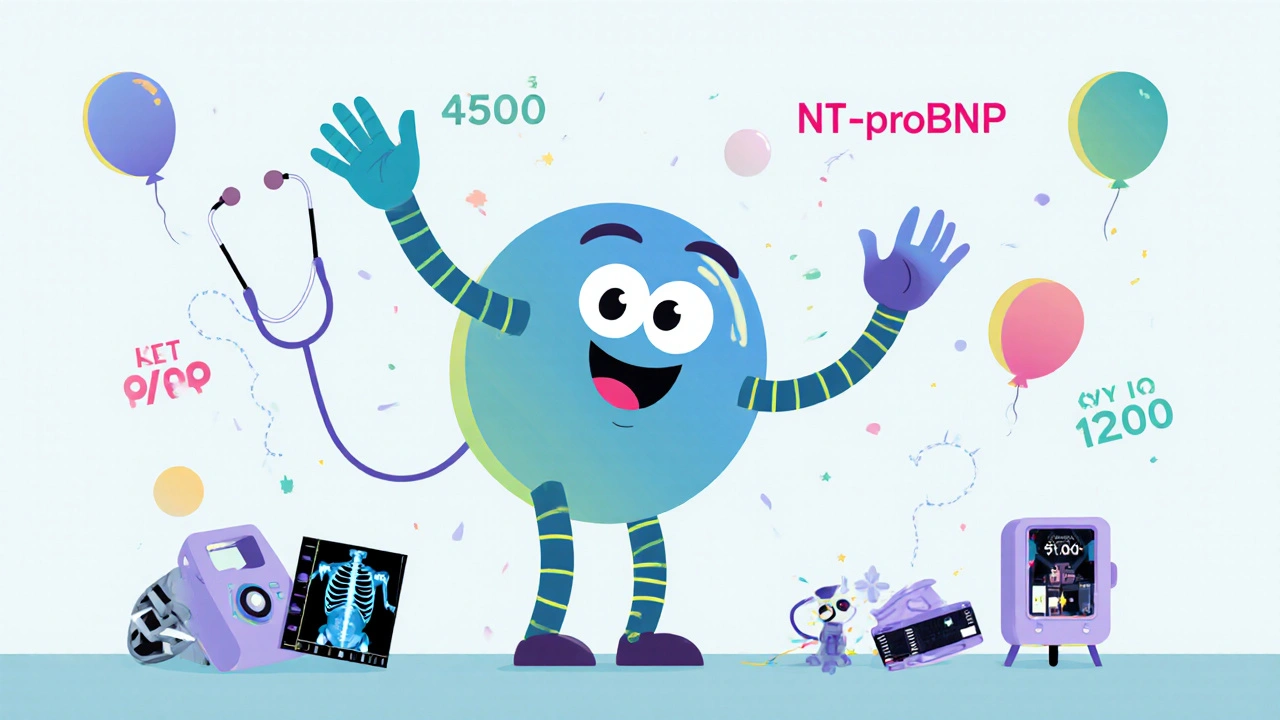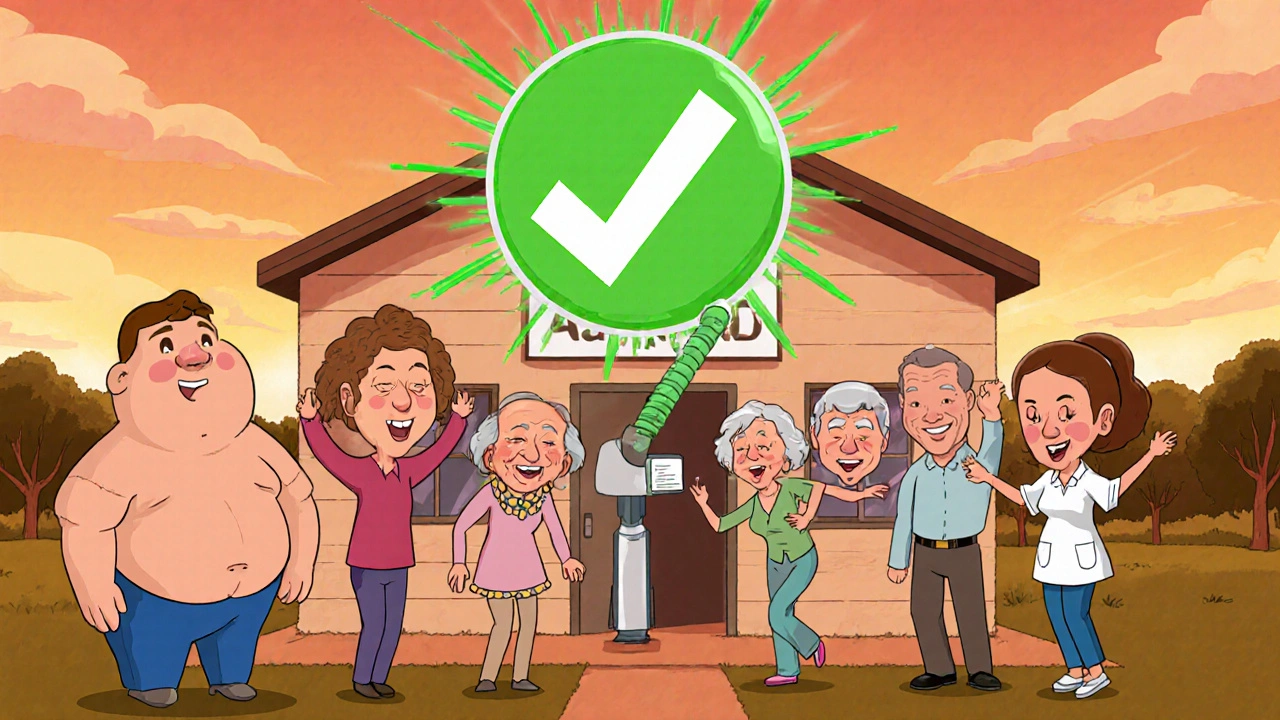
When a patient walks into the ER with shortness of breath, the clock starts ticking. Is it heart failure? COPD? A pulmonary embolism? In the past, doctors relied on chest X-rays, EKGs, and physical exams-often leading to long waits, unnecessary scans, and misdiagnoses. Today, a simple blood test can cut through the noise. NT-proBNP is that test. It’s not just another lab order. It’s a game-changer for ruling out heart failure in minutes, not hours.
What NT-proBNP Actually Measures
NT-proBNP stands for N-terminal pro-B-type Natriuretic Peptide. It’s a protein fragment released by the heart’s left ventricle when it’s stretched from too much pressure or fluid. Think of it like a distress signal. The more the heart is struggling, the higher the level in your blood. Unlike BNP, which breaks down quickly, NT-proBNP stays stable in the bloodstream for hours. That makes it easier to test-even if the sample sits for a bit before being analyzed.
The test is measured in picograms per milliliter (pg/mL). Most hospitals use the Roche Elecsys® assay, which can detect levels as low as 5 pg/mL. Results typically come back in under an hour. For emergency departments, that speed matters. A level below 300 pg/mL almost always means heart failure isn’t the cause. That’s a 98% negative predictive value. In plain terms: if it’s under 300, you can safely move on to other causes.
When to Order NT-proBNP-The Clear Indications
There are five clear, guideline-backed situations when you should order this test:
- Suspected acute heart failure-especially in patients with new or worsening shortness of breath, swelling in the legs, or fatigue. This is the #1 reason. The 2023 ESC guidelines give it a Class I recommendation-the strongest possible.
- Emergency department triage-for any patient over 50 with unexplained dyspnea. NICE guidelines in the UK say every ED should have NT-proBNP available within 2 hours. CMS data shows hospitals that do this reduce unnecessary echocardiograms by 19%.
- Rule-out in elderly patients-older adults often have vague symptoms. A 78-year-old with mild fatigue might be written off as "just aging." But if their NT-proBNP is 140 pg/mL, heart failure is extremely unlikely. That avoids a cascade of tests.
- Monitoring known heart failure-levels that rise over weeks suggest worsening disease. A drop after treatment means the meds are working. It’s not for daily tracking, but every 3-6 months in stable patients helps guide therapy.
- Risk stratification after acute coronary syndrome-new 2024 guidelines from ACC/AHA/HFSA now recommend NT-proBNP testing within 24 hours of a heart attack. High levels predict higher risk of death or rehospitalization in the next year.
These aren’t opinions. They’re backed by 28 years of outcome data. The test is included in 94% of major cardiovascular guidelines. It’s not optional-it’s standard.
When Not to Order It-or How to Interpret It Carefully
NT-proBNP isn’t perfect. Misinterpreting it causes more harm than not ordering it.
Age matters. Levels naturally rise with age. A 65-year-old might have a normal level of 600 pg/mL, while the same number in a 40-year-old would be a red flag. Use age-adjusted cutoffs: under 50, rule-out is <450 pg/mL; 50-75, <900 pg/mL; over 75, <1,200 pg/mL.
Kidney problems change everything. If someone has stage 3 or worse chronic kidney disease, NT-proBNP levels rise even without heart failure. That’s because the kidneys clear it out. In these patients, the rule-out threshold jumps to <1,200 pg/mL. Don’t assume high = heart failure. Always check eGFR.
Obesity lowers levels. Fat tissue absorbs some of the peptide. For every 5-point increase in BMI, levels drop 25-30%. A 200-pound patient with a level of 400 pg/mL might actually have significant heart failure. Don’t dismiss it just because the number seems "low."
AFib and pulmonary hypertension also elevate levels. Atrial fibrillation alone can push NT-proBNP up by 200-300 pg/mL. Same with severe lung disease. Context is everything. A level of 850 pg/mL in a 78-year-old with AFib and COPD? That’s not a diagnosis-it’s a puzzle. You need echo, clinical history, and maybe a lung scan.

Why NT-proBNP Beats BNP in Real-World Use
There are two main natriuretic peptide tests: BNP and NT-proBNP. So why does NT-proBNP dominate 68% of U.S. orders?
- Stability: BNP breaks down in 20 minutes. NT-proBNP lasts 60-120 minutes. That means you can draw the blood, transport it, and process it without worrying about degradation.
- Accuracy: A 2020 meta-analysis found NT-proBNP had a higher diagnostic accuracy (AUC 0.91) than BNP (0.88). It correlates better with echo findings.
- Consistency: The Roche assay has a coefficient of variation under 3.5% across its entire range. That means repeat tests are reliable.
BNP still has its place-mainly in hospitals using older platforms. But if you’re starting fresh, NT-proBNP is the standard.
What Happens When You Don’t Use It
Skipping NT-proBNP isn’t just outdated-it’s risky.
One 2022 study in JAMA Internal Medicine found that hospitals without standardized NT-proBNP protocols had 33% more inappropriate testing. That means unnecessary echocardiograms, CT scans, and even cardiac catheterizations. Each extra test costs $1,500-$3,000. It delays care. It exposes patients to radiation or contrast dye.
And the human cost? A 2023 Medscape survey showed 76% of cardiologists say NT-proBNP prevents avoidable hospitalizations. One ER doc in Texas told me about a patient with COPD whose NT-proBNP was 120 pg/mL. Without the test, she would’ve been admitted for "heart failure"-given diuretics, monitored for days, and discharged with no real diagnosis. The test showed it was just a bad lung flare-up. No hospital stay. No IVs. No cost. Just relief.

What’s Changing in 2025
Two big shifts are happening now.
First, CMS is rolling out prior authorization for NT-proBNP tests ordered in asymptomatic patients. If someone has no symptoms, no history of heart disease, and no signs of fluid overload-don’t order it. Medicare data shows 18% of tests are wasted this way. Starting January 2025, those will need pre-approval.
Second, point-of-care testing is here. Roche’s Cobas h 232 device delivers NT-proBNP results in 12 minutes-right at the bedside. That’s a game-changer for urgent care centers and rural hospitals. Concordance with lab results? 94.7%. No more waiting for the lab.
The test isn’t going away. Evaluate MedTech projects NT-proBNP will remain the gold standard through 2030. Even with new multi-marker panels coming, nothing else has 28 years of outcome data behind it.
Bottom Line: Don’t Guess. Test.
Heart failure kills. But it’s often missed-or overdiagnosed. NT-proBNP cuts both ways. It prevents false positives and false negatives. It saves money. It saves time. It saves lives.
Order it when someone has unexplained dyspnea. Especially if they’re over 50. Especially if they’re in the ER. Especially if they have kidney disease or obesity-just adjust the cutoffs. Don’t rely on it alone. But don’t ignore it either.
The data is clear. The guidelines are strong. The technology is fast. The cost is low-$18.42 per test. The benefit? A 98% chance you’re not missing heart failure. That’s not just good medicine. It’s essential medicine.
What is a normal NT-proBNP level?
There’s no single "normal" level-it depends on age. For patients under 50, a level under 450 pg/mL rules out acute heart failure. For those 50-75, under 900 pg/mL. For patients over 75, under 1,200 pg/mL. In healthy adults with no heart issues, levels are typically under 100 pg/mL. Always use age-adjusted cutoffs, not fixed numbers.
Can NT-proBNP be high without heart failure?
Yes. Several conditions can raise NT-proBNP without heart failure: chronic kidney disease (especially stages 3-5), atrial fibrillation, severe lung disease like COPD or pulmonary hypertension, recent heart attack, and advanced age. In these cases, the test is still useful, but interpretation requires context. A high level doesn’t automatically mean heart failure-it means more investigation is needed.
How long does it take to get NT-proBNP results?
In most hospital labs, results are available in 47 minutes on average. With new point-of-care devices like the Roche Cobas h 232, results can be ready in as little as 12 minutes at the bedside. This speed is critical in emergency settings where decisions need to be made quickly.
Is NT-proBNP testing covered by insurance?
Yes. Medicare reimburses $18.42 per NT-proBNP test in 2025. Most private insurers follow Medicare’s lead. The test is included in all major heart failure guidelines, so it’s considered medically necessary when ordered for suspected heart failure, dyspnea, or risk stratification after a heart attack. Prior authorization is now required for asymptomatic patients starting January 2025.
Should I order NT-proBNP for all patients with shortness of breath?
No-not for everyone. It’s most useful for patients over 50 with new or worsening symptoms like dyspnea, fatigue, or swelling. Avoid ordering it for asymptomatic patients, those with clear non-cardiac causes (like pneumonia), or those with end-stage renal disease on dialysis. Use clinical judgment. The goal is to rule out heart failure efficiently, not to test everyone.
What if NT-proBNP is normal but I still suspect heart failure?
If NT-proBNP is below the age-adjusted cutoff (e.g., <300 pg/mL for acute cases), heart failure is very unlikely. But if clinical signs are strong-like jugular venous distension, crackles in the lungs, or sudden weight gain-consider other causes. A normal NT-proBNP doesn’t rule out all types of heart disease. For example, diastolic heart failure (HFpEF) can sometimes have normal or only mildly elevated levels. An echocardiogram may still be needed to confirm.
Comments (12)
-
Sandi Moon November 19, 2025
Let me tell you something the pharmaceutical lobby doesn't want you to know-NT-proBNP testing is just the latest shiny object to replace clinical judgment. They've been pushing this for years, but have you ever seen the actual mortality data? It's not the miracle they claim. In fact, in rural UK hospitals, we've seen more patients misdiagnosed because doctors stopped listening and started trusting machines. The real crisis isn't heart failure-it's the erosion of the doctor-patient relationship. And don't get me started on how labs profit from this. The Roche Elecsys® assay? A $2000 machine that charges you $80 per test. That's not medicine. That's corporate theater.
-
Kartik Singhal November 20, 2025
Brooo, this test is literally the GOAT 🙌. I mean, who even needs a stethoscope anymore? My cousin in Delhi got diagnosed with HF in 45 mins thanks to this-no CT, no echo, no waiting. And the best part? The algorithm auto-adjusts for age. 🤯 I used to think medicine was about intuition, but now? It's math. And math doesn't lie. Also, I'm starting a YouTube channel called 'NT-proBNP or Bust'-subscribe? 📈❤️
-
Logan Romine November 20, 2025
So we’ve replaced the soul of medicine with a number, huh? 🤔 The heart doesn’t whisper-it screams in picograms per milliliter now. And we call that progress? I mean, if your soul could be quantified, would you want it measured by a machine that doesn’t know the difference between grief and volume overload? NT-proBNP doesn’t care that your patient lost his wife last week. It just sees a 650 pg/mL and says ‘cardiomyopathy.’ Maybe the real disease here is our refusal to sit with uncertainty. 🌌
-
Chris Vere November 21, 2025
This is a good summary of the current guidelines and I appreciate the clarity. In Nigeria we don't always have access to these tests but when we do, the impact is profound. Elderly patients with vague symptoms often go undiagnosed for months because we lack imaging. NT-proBNP gives us a bridge. We still rely on clinical intuition but now we have a tool that reduces guesswork. The age-adjusted thresholds are critical. We must not forget that in low resource settings, even a simple blood test can be a lifeline.
-
Pravin Manani November 21, 2025
From a clinical perspective, the 98% negative predictive value is the real MVP here. When you're triaging 12 patients in an ED with dyspnea, and 7 of them have NT-proBNP <300, you can confidently pivot to pulmonary embolism, pneumonia, or anxiety without ordering 7 echocardiograms. The cost savings alone justify institutional adoption. Also, the 2024 ACC/AHA/HFSA update on post-ACS risk stratification is a game-changer-elevated levels correlate with 3x higher 1-year mortality. This isn't just diagnostic-it's prognostic. We're moving from reactive to predictive cardiology.
-
Mark Kahn November 22, 2025
Love this breakdown! Seriously, if you're in the ER and someone comes in wheezing, this test is your best friend. I used to stress over every case, but now? I order it first thing. It saves time, money, and honestly-saves lives. And the best part? Patients feel heard because we’re not just guessing anymore. You’re doing great work sharing this. Keep it up! 💪❤️
-
Leo Tamisch November 24, 2025
Oh look, another ‘evidence-based’ magic bullet™. Let me guess-next they’ll be testing your tears for existential distress. 🤡 NT-proBNP? Cute. But let’s be real: 94% of guidelines include it because Big Pharma funded 94% of the studies. And don’t even get me started on ‘age-adjusted cutoffs.’ So now we’re not just treating patients-we’re categorizing them by birth year? How progressive. Also, why does everyone act like this test is new? It’s been around since 2001. We just forgot how to listen until the algorithm told us to.
-
Daisy L November 24, 2025
OH MY GOSH-THIS IS THE MOST IMPORTANT THING I’VE READ THIS YEAR!!! 🚨🚨🚨 We’re literally saving lives with a single drop of blood!!! Why isn’t this on the nightly news?!?!? The fact that we can rule out heart failure in minutes?!?!? I’m crying. I’m so proud of modern medicine!!! Who needs intuition when you have SCIENCE?!?!? #NTproBNPRevolution #HeartFailureIsOver #ScienceWins
-
Anne Nylander November 24, 2025
omg this is so cool!! i had no idea this test even existed!! my dad had shortness of breath last year and they did like 5 tests and waited days… if they had this he would’ve been home in hours!! love how fast it is!! 🥹❤️
-
Franck Emma November 25, 2025
They’re turning hearts into bar graphs.
-
Noah Fitzsimmons November 27, 2025
Wait, so you’re telling me we’ve been diagnosing heart failure wrong for decades? And now you want me to believe this one test is the answer? I’ve seen patients with 280 pg/mL who had massive infarcts. You think a number replaces auscultation? You think a machine knows the difference between a wheeze and a gallop? I’ve been doing this since 1998. I don’t need your algorithm. I need my ears.
-
Cooper Long November 29, 2025
In many African and Asian healthcare systems, access to NT-proBNP remains a luxury. Yet when available, it has transformed triage protocols in urban centers. The challenge is not the science-it is equity. We must ensure that this tool does not become a marker of privilege. The guidelines are sound. The implementation must be just. The test is not the end-it is the beginning of a more equitable diagnostic paradigm.
